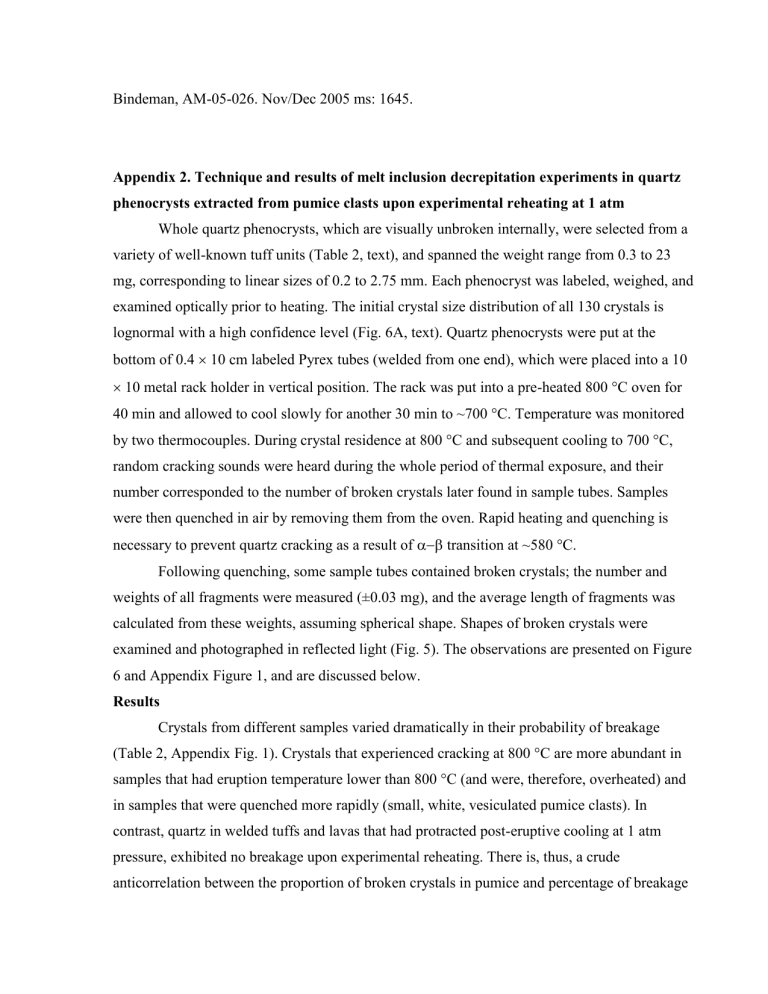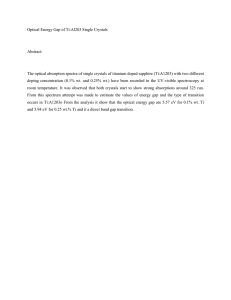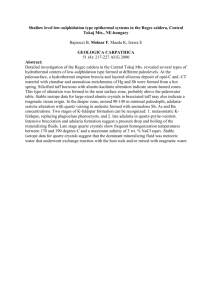Bindeman_p1801_05_A2.doc

Bindeman, AM-05-026. Nov/Dec 2005 ms: 1645.
Appendix 2. Technique and results of melt inclusion decrepitation experiments in quartz phenocrysts extracted from pumice clasts upon experimental reheating at 1 atm
Whole quartz phenocrysts, which are visually unbroken internally, were selected from a variety of well-known tuff units (Table 2, text), and spanned the weight range from 0.3 to 23 mg, corresponding to linear sizes of 0.2 to 2.75 mm. Each phenocryst was labeled, weighed, and examined optically prior to heating. The initial crystal size distribution of all 130 crystals is lognormal with a high confidence level (Fig. 6A, text). Quartz phenocrysts were put at the bottom of 0.4 10 cm labeled Pyrex tubes (welded from one end), which were placed into a 10
10 metal rack holder in vertical position. The rack was put into a pre-heated 800 °C oven for
40 min and allowed to cool slowly for another 30 min to ~700 °C. Temperature was monitored by two thermocouples. During crystal residence at 800 °C and subsequent cooling to 700 °C, random cracking sounds were heard during the whole period of thermal exposure, and their number corresponded to the number of broken crystals later found in sample tubes. Samples were then quenched in air by removing them from the oven. Rapid heating and quenching is necessary to prevent quartz cracking as a result of transition at ~580 °C.
Following quenching, some sample tubes contained broken crystals; the number and weights of all fragments were measured (±0.03 mg), and the average length of fragments was calculated from these weights, assuming spherical shape. Shapes of broken crystals were examined and photographed in reflected light (Fig. 5). The observations are presented on Figure
6 and Appendix Figure 1, and are discussed below.
Results
Crystals from different samples varied dramatically in their probability of breakage
(Table 2, Appendix Fig. 1). Crystals that experienced cracking at 800 °C are more abundant in samples that had eruption temperature lower than 800 °C (and were, therefore, overheated) and in samples that were quenched more rapidly (small, white, vesiculated pumice clasts). In contrast, quartz in welded tuffs and lavas that had protracted post-eruptive cooling at 1 atm pressure, exhibited no breakage upon experimental reheating. There is, thus, a crude anticorrelation between the proportion of broken crystals in pumice and percentage of breakage
upon experimental reheating. Demonstrating this even more clearely are the broken crystals from clasts in different stratigraphic units of Bishop tuff. Fewer quartz crystals from the lateerupted and hotter Bishop clasts got broken upon reheating, than the early erupted colder clasts.
This finding is opposite to the observed proportion of broken crystals in the same pumice clasts: late-erupted and greater decompressed clasts contain more broken crystals than early erupted
Bishop quartz (Wallace et al. 1999).
The breakage observed due to overheating will be similar if a set of more extreme decompression experiments were conducted. Allen and McPhie (2003) described small number of fragments generated around exploded melt inclusions seen in thin sections, which they interpret to result from syneruptive decompression.
Interpretation
The observed MI decrepitation and phenocryst breakage were caused by overheating, decompression, and kinetic factors of crack propagation/healing during thermal exposure (e.g.,
Wanamaker et al. 1990). The kinetics and duration of crack propagation are on the order of minutes to hours, and protracted isothermal exposure of crystals at 1 atm leads to decompressive fragmentation. While small, white pumice clasts “quench” preeruptive conditions rather effectively, including Fe 3+ /Fe 2+ ratio (Tait et al. 1998); slower-cooling, larger pumice clasts, or ignimbrite sheets exhibit more significant syn- or posteruptive crystal fracturing, following eruptive decompression.
Many of initial samples of this study (Table 2) were small (1 10 cm) pumice clasts of white to light-pink color. They are expected to have cooled and quenched rapidly upon eruption at time scales on the order of minutes (Anderson 1990; Tait et al. 1998); thus, most melt inclusions inside quartz and feldspars would have survived eruption based on such a rapid quench. The CSDs in these clasts measured by Bindeman (2003), and FSD of this study are thus characteristic of that magma prior to its disintegration into single clasts. The pressure within melt inclusions are expected to be close to that prior to decompression (Fig. 9B, text).
Appendix 2 Figure 1. Crystal breakage as a result of melt inclusion decrepitation upon experimental heating to 800 °C in a series of samples (Table 2, text). Parents are whole crystals of quartz, daughters are fragments resulted from breakage of parents, and are plotted
1
immediately below each parent. Notice that only one third of crystals broke; some samples exhibited no breakage, whereas in others, nearly all crystals broke to 2 3 smaller pieces (see text for discussion).
2




